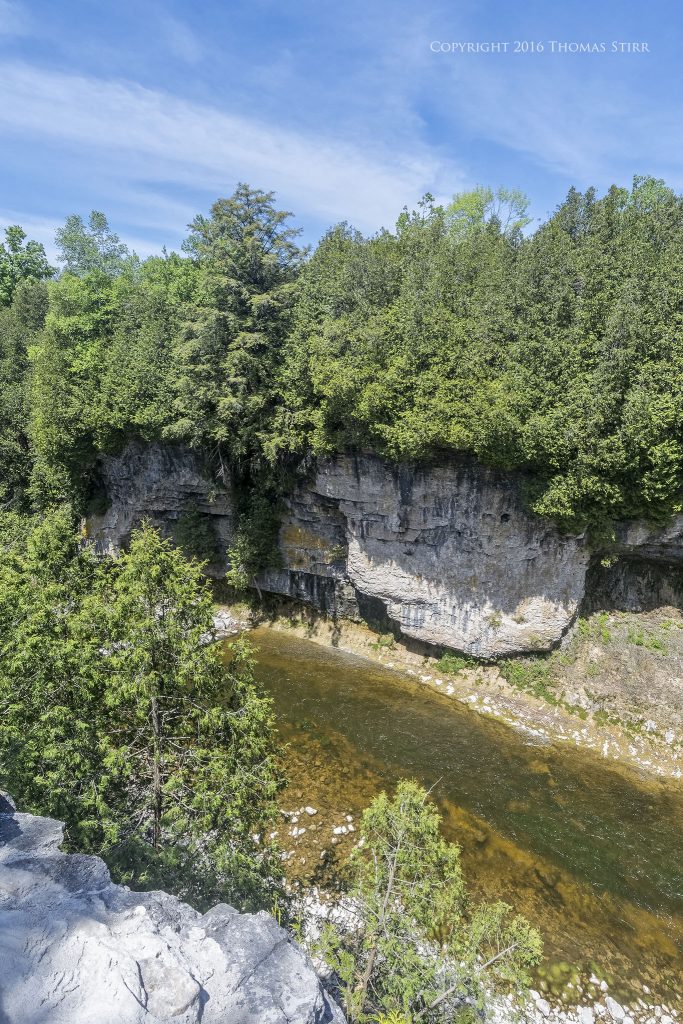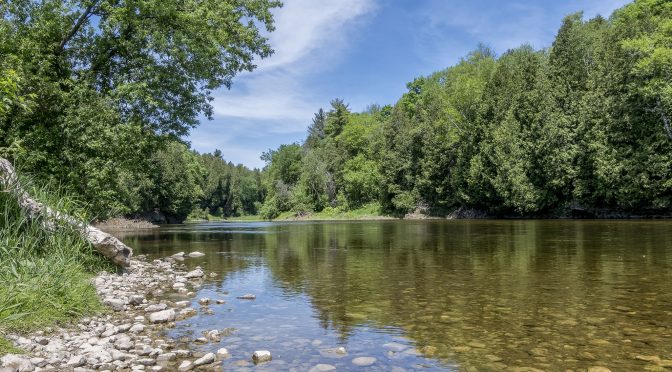It has been many years since I visited Elora Gorge and I decided to make some time in my schedule to do so. So, I grabbed a Nikon 1 J5 and a couple of 1 Nikon lenses and headed off to see what kinds of images I could capture at the Elora Gorge Conservation Area.
This park is run by the Grand River Conservation Authority and is open from April 30 through to October 16. Daily admission varies from $3 for children to $6 for adults. Seniors are $5.25.
NOTE: Click on images to enlarge.

There is ample parking at the facility, with many of the lots close by to the various hiking trails at the site.
The image above is representative of the forested trails that you’ll hike along to reach the gorge lookouts.

Hiking through forested trails has a sameness about it, so I tend to look for unusual rocks, roots and other details at my feet.

To reach one of the gorge lookouts one must navigate some stairs with a railing that snakes through a natural hole in the rock.

Once at the bottom of the stairs the ruggedness of the side of the gorge is evident.

There is a large formation of tree roots in the centre of the lookout that can yield some abstract images.

The actual view of the gorge and the Grand River is somewhat limited but there are a couple of decent views.

Returning to the main trail enables a completely different perspective of the steel staircase, along with some interesting lighting.

My J5’s small BSI sensor has better dynamic range and colour depth as compared to my V2’s. While not at the levels of a full frame or cropped sensor, there was noticeably more in the files with which to work compared to the Aptina sensors in other Nikon 1 models.

Based on my preferences, I found that the best image opportunities were at the ‘low bridge’ area which brings you down into the gorge at river level.

Parking is at the top of the other side of the gorge so a short hike is required to get back to the ‘low bridge’ area, but it is worth the effort.

When visiting this area of the Elora Gorge Conservation Area it’s not a bad idea to have a long telephoto zoom lens with you as there are often a number of bird species by the river.

On the afternoon of my visit I spotted a couple of ospreys, a few other raptors, and three or four Baltimore Orioles.

There are views of Elora Gorge from a roadway bridge as well. There is no parking in the area of the bridge so you’ll need to park closer to town and take a short walk back to the bridge. The image below was captured from the road bridge that overlooks the gorge.

There are a number of activities at the Elora Gorge Conservation Area and interested readers can use the link to get more information.
Technical Note:
All photographs in this article were captured hand-held using a Nikon 1 J5 with 1 Nikon 10-100 mm f/4-5.6 and 6.7-13 mm f/3.5-5.6 zoom lenses. The images were produced from RAW files using my standard process of OpticsPro 10 Elite, CS6 and Nik Suite.
My intent is to keep this photography blog advertising free. If you enjoyed this article and/or my website and would like to make a modest $10 donation through PayPal to support my work it would be most appreciated. You can use the Donate button below. Larger donations can be made to tom@tomstirr.com through PayPal.
Article and all images are Copyright 2016 Thomas Stirr. All rights reserved. No use, duplication or adaptation of any kind is allowed without written consent. If you see this article reproduced anywhere else it is an unauthorized and illegal use.


Nice photos. Nice compositions. I was in a similar park in bangalore and could not quite get the sharpness of your first image showing a free trunk and beyond. I tried a similar shot with my d3200 35mm f1.8g lens. Where do I focus in such a situation. I shot at f 5.6 and 7.1 but for blurry green. And my lens does not have infinity focus but how do I capture an image as you did for the reflection where image is sharp. For the rule of one third or calculating hyperfocal diatance with an app how do I focus since the nearest object is the tree at such a long distance. Good shots as usual. Please do not mind my basic questions.
Keep the good work coming.
Srikanth
Hi Srikanth,
In terms of the first image I shot I used an aperture of f/8 with single point auto-focus positioned on the trunk of the tree on the right hand side of the photograph. My Nikon 1 J5 has a smaller sensor than does your APS-C so to achieve an equivalent field of view of 36mm my 10-100mm f/4-5.6 was set at 14mm. You need to keep in mind that wider angle lenses (or lens settings) produce different depth-of-field properties, i.e. a 14mm lens performs quite differently than does a 35mm.
I haven’t shot with an APS-C camera for a few years so I don’t remember how I would have handled things with the gear that you note in your comment. I went on-line and played around with a depth-of-field calculator. It appears that to achieve infinity focus using a 1.5X cropped sensor camera with a 35mm lens you would need to be about 6 meters away from the tree on the right hand side and shoot at f/11. My guess is that the resulting image would have needed to be cropped to get the same framing as my image. I tried to replicate my first image using the DOF calculator and at f/8, using a Nikon 1 camera with a 14mm lens, infinity focus could be achieved when standing 2.25 meters away from the tree on the right hand side of the image, which from memory, was about my position to capture the first image in my article.
Hope this has helped.
Tom
Your quick reply is much appreciated. Thanks.
Srikanth
I love your walkabout shares:) your images are lovely, and you do very little fussing with them! I think thats what makes them even more pleasing;)
Thanks Linda – I’m glad you enjoyed the images! I would much rather be out taking images with my cameras than spend untold hours fixated on one image in post. I’m not sure if that qualifies me as a ‘lazy photographer’ or not… 🙂
Tom